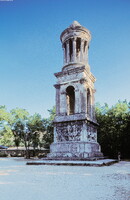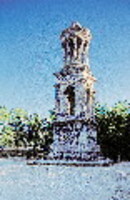| dc.coverage.spatial | Site: Glanum, Provence-Alpes-Côte d'Azur, France | en_US |
| dc.coverage.temporal | ca. 29-20 BCE (creation) | en_US |
| dc.creator | unknown (Ancient Roman) | en_US |
| dc.date | 29-20 | en_US |
| dc.date.accessioned | 2013-02-25T17:46:18Z | |
| dc.date.available | 2013-02-25T17:46:18Z | |
| dc.date.issued | 29-20 | en_US |
| dc.identifier | 195861 | en_US |
| dc.identifier.other | archrefid: 1646 | en_US |
| dc.identifier.uri | http://hdl.handle.net/1721.3/103369 | |
| dc.description | General view of the tower; Close by to the triumphal arch is a virtually intact cenotaph, the well-known Cenotaph of the Julii. dating from the 20s BCE, one of the best preserved to be found anywhere in the Roman world. The inscription can still clearly be discerned. The tiered form is unusual. At the base is a pedestal carved with historical and mythical reliefs. The cenotaph is topped with a structure strongly resembling a round temple or tholos, which houses statues of the dedicatees (the lost heads were replaced in the eighteenth century). Source: Wikipedia; http://en.wikipedia.org/wiki/Main_Page (accessed 7/17/2008) | en_US |
| dc.format.medium | stone | en_US |
| dc.rights | © Scott Gilchrist, Archivision, Inc. | en_US |
| dc.subject | allegorical | en_US |
| dc.subject | architectural exteriors | en_US |
| dc.subject | death or burial | en_US |
| dc.subject | Imperial (Roman) | en_US |
| dc.title | Glanum: Cenotaph of the Julii | en_US |
| dc.title.alternative | Cenotaph of the Julii | en_US |
| dc.type | image | en_US |
| dc.rights.access | Licensed for educational and research use by the MIT community only | en_US |
| dc.identifier.vendorcode | 1A3-R-F-G-A1 | en_US |
| vra.culturalContext | Ancient Roman | en_US |
| vra.technique | carving (processes) construction (assembling) | en_US |
| vra.worktype | monument | en_US |
| dc.contributor.display | unknown (Ancient Roman) | en_US |



